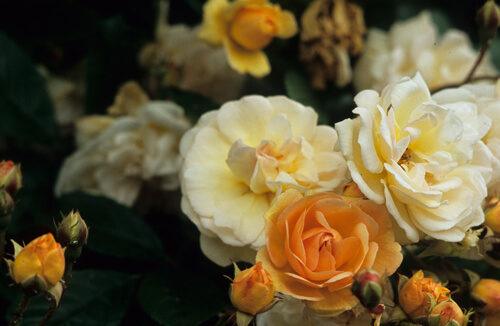
You can grow beautiful roses in western Washington if you choose disease-resistant varieties and take steps to keep them healthy. Photo: Great Plant Picks.
Many people love the beauty and fragrance of roses. But growing roses in western Washington can be challenging. Our moist, cool weather is ideal for diseases such as black spot, rust and powdery mildew.
Roses are high-maintenance plants in our region. They are not part of our regular tree and shrub care program. Still, you can grow roses here if you take steps to reduce problems.
TIPS FOR ROSE CARE
Purchase disease-resistant plants. “Disease-resistant” doesn’t mean your rose is guaranteed to be problem-free, but it is less likely to succumb to diseases. Here are several lists of roses that are likely to perform well in our damp conditions.
- Seattle Rose Society: Roses for Puget Sound Gardens
- Seattle Times: 5 perfect rose varieties for a Pacific Northwest garden
- North Coast Gardening: Disease-Resistant Roses for the Pacific Northwest
- Better Homes and Gardens: Top Roses That Thrive in the Pacific Northwest
- Fine Gardening, Extraordinary Roses for the Northwest
- Oregon State University Extension Service: Old garden roses
Plant roses where they get plenty of sun—at least six hours a day—and good air circulation. Plant bushes at least three feet apart to encourage air flow.
Remove all leaves up to 1 to 1-1/2 feet off the ground to prevent water and disease spores from splashing onto them.
Mulch your roses. Spread a 2″ to 3″ layer of mulch around each plant, keeping the mulch a few inches away from the trunk. Mulch can help prevent disease spores from reaching the plant. Mulch will also conserve moisture, control weeds, improve soil structure and protect roots from hot and cold weather. Add new mulch every year to reduce the spread of disease.
Do not prune your roses too early. A good time to prune roses is March 1st. Pruning too early can force growth that can be susceptible to a cold spell.
When pruning, always prune out all the dead and diseased wood. Cut out the old wood by cutting below the wood into healthy tissue. Larger cuts may need to have a pruning sealer applied to the wound. Pruning cuts should be done so that the upper bud is facing the outside of the plant. Roses require and respond well to proper pruning.
Remove all diseased leaves and blooms regularly. Do not compost them in your home compost bin. They need to be composted in high heat to kill disease spores.
HOW TO TREAT ROSE DISEASES
For powdery mildew (but not black spot): Put one teaspoon of baking soda into a quart of water. Add a few drops of dishwashing liquid (not detergent). Spray the mixture weekly in spring before disease symptoms appears. The baking soda alters the pH of the leaf surface enough that disease organisms find it difficult to colonize the surface.
A product called Messenger (harpin protein) increases the resistance of plants to diseases. It provokes an immune response in the plant similar to a vaccination in humans.
Some less-toxic fungicides are on the market. They contain sulfur, neem oil or potassium bicarbonate (similar to baking soda).
In Harmony doesn’t advise any other treatment for rose diseases. Most other fungicides are toxic to humans and the environment. You may need to accept that your roses will get some black spot. The blossoms will still be gorgeous.

It turns out that Messenger is no longer being sold. However, you can still buy harpin protein under the brand name Axiom, https://www.rxgreensolutions.com/axiom-harpin-proteins.html.
Moved here from TX and had excellent results there with “foundling” roses that had been found in old homesteads or old cemeteries that thrived on neglect. They tended to be black spot and mildew resistant as well as aphid resistant. Would like to locate same type of roses that grow well in the Puyallup WA area. A climber is acceptable—frangrance is a non-issue. Looking for something that has a showy larger bloom, not a bloom the size of a thumbnail. Also want one that blooms throughout the entire summer. Requesting suggestions since we haven’t a clue what will do best in this climate.
Hello, thanks for your comment. Growing roses in our damp climate is a challenge. Here are some rose recommendations from Great Plant Picks.
https://www.greatplantpicks.org/plantlists/saved_searches/1632
And another list from the Seattle Rose Society.
http://seattlerosesociety.org/roses-for-puget-sound-gardens/
Good luck! Enjoy your roses. They are still beautiful even if they get some black spot.
So…..if I’m understanding this correctly. Here in Washington (by MT. Vernon) , i should wait until the end of February or March 1st to trim roses to the appropriate heights and not in November when the cold comes?
That is correct. Many people don’t deadhead after August or September to allow the plan to harden off for winter. You could perhaps do minor pruning in winter to reduce tall branches. But major pruning to reduce the overall size of the plant should be done in late February or early March.
Thank you very much for the information.
You are very welcome. I’m glad we could help.
All of the links to lists of roses in the main article are broken.
Thanks for letting us know. I have updated the article with new links and some additional resources.